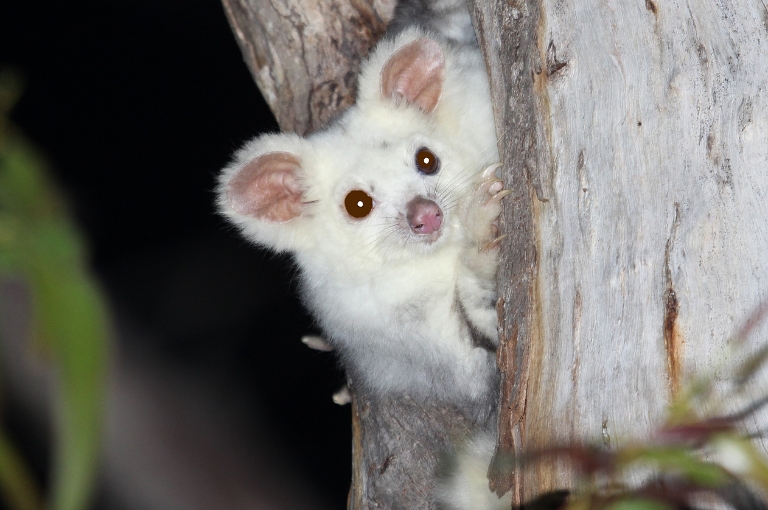
A recent survey in the Greater Blue Mountains has surprised ecologists by finding a significantly increased population and good post-fire recovery of the Southern Greater Glider in the vicinity of Wombeyan Karst Conservation Reserve. With the 2019-2020 Black Summer bushfires resulting in an estimated 60% decline in the species in the region, these results are encouraging.
In Autumn 2023, as part of an annual post-fire monitoring program, ecologists Peter and Judy Smith were engaged by Kanangra-Boyd to Wyangala (K2W) Link Inc to survey the Wombeyan and Jenolan Karst Conservation Reserves to assess the post-fire recovery of gliders and other tree-dwelling mammals. Funding for the repeat survey was provided by the Great Eastern Ranges and WWF-Australia as part of a broader bushfire recovery effort in the state.
The ecologists used spotlights to search through the tall forests for mammals over three nights along the same seven transects, counting the number of animals they saw. The 500m transects have been surveyed annually during the drought and extreme heatwaves that proceeded the fires. The Smiths recorded six species of forest-dependant mammals during the Autumn survey, including three threatened species (southern greater glider, yellow-bellied glider and spotted-tailed quoll) and four non-threatened species (feathertail glider, krefft’s glider and common brushtail possum).
“The survival and recovery of southern greater gliders in the less badly burnt forests has been much better than expected and is very encouraging. They have been able to survive in sites where there was at least some live eucalypt foliage for them to feed on in the immediate aftermath of the fires. They have recovered rapidly because of the good rainfall and plant growth in the years since the fires,” the Smiths said.
“The tall forests in the eastern parts of the K2W Link support unusually high numbers of southern greater gliders and are a critically important refuge for the species in this region.”
The Smiths say that the tall, moist forests in and around the south-western corner of the Blue Mountains World Heritage Area are a favoured habitat of the southern greater glider. They provided an important refuge for the marsupials during and after the prolonged drought and 2019-2020 bushfires, and also provides a more favourable climate for the heat sensitive species which has been retreating from warmer, lower elevations in the Blue Mountains since the 1990s.
“The first post-fire breeding season in 2020 was unsuccessful,” the Smiths said. “However, there was an increase in the Southern Greater Glider population following the 2021 breeding season and there has now been a further increase following the 2022 breeding season.”
Trends in the sightings of southern greater gliders
The increase has been greatest in the transects that were unburnt or only lightly burnt, which are also the tallest forests and best glider habitat sampled, supporting higher glider densities than the other transects. The numbers of Southern Greater Gliders recorded on these transects in Autumn 2023 were 89% higher than the first post-fire counts in 2020 and 64% higher than the numbers recorded in pre-fire, pre-drought surveys in 2016. This is attributed to the remarkable increase in the wet La Nina conditions since the fires, which have promoted abundant regrowth of soft young eucalypt foliage for the gliders to feed on.

However, the Smiths’ found no sign of recovery in the severely burnt transects, where southern greater gliders are thought to have been eliminated by the fires and have not reappeared since.
“The severely burnt transects are a different story and the species is likely to be absent from these transects for years to come, as seen in Sydney’s Royal National Park, following the 1994 bushfires, where southern greater gliders were wiped out and did not recolonise until 18 years later.”
“Although the lack of recovery in severely burnt forests is worrying, the survival and recovery of southern greater gliders in the less badly burnt forests has been much better than expected and is very encouraging,” the Smiths said.
The Smiths warn that “survival of the species in the long term will depend on whether the Black Summer bushfires were an exceptional event that will not recur for many decades or whether they are the start of a permanent change in the fire regime to more frequent, more extensive, more severe wildfires as a result of climate change.
“Such a drastic change in the fire regime would have catastrophic effects on many animal and plant species.”
Click here to view the full survey report.



 Media release
Media release